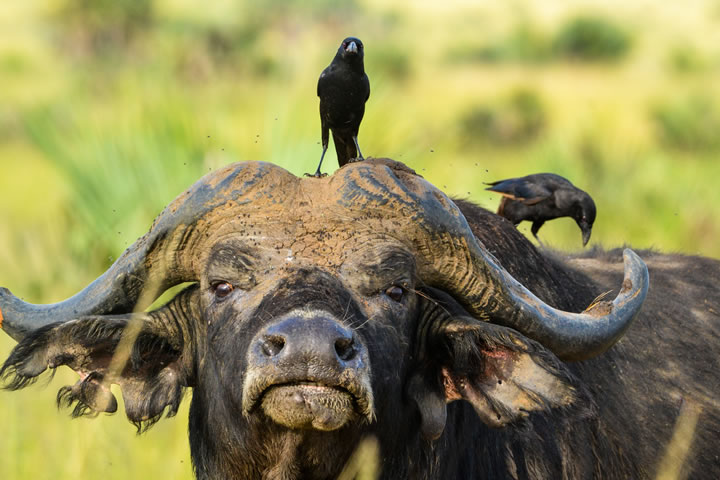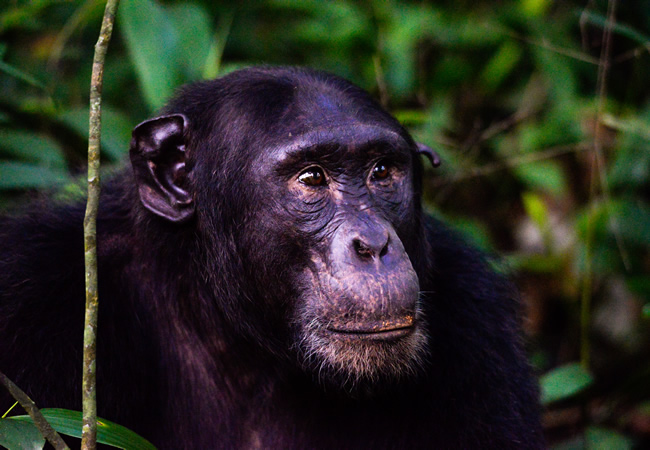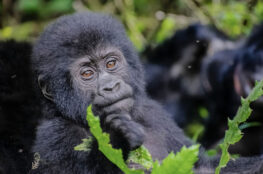Queen Elizabeth National Park is the most popular safari destination in Uganda, located in the western region. The park was established in 1952 as Kazinga National Park before it was renamed Queen Elizabeth National Park. It was named after the Queen of England, Queen Elizabeth II, after she paid a visit to the park in 1954.
The park covers the districts of Kasese, Rubirizi, Kanungu, and Kamwenge. Queen Elizabeth is famous for being home to the rare tree-climbing lions and the Kazinga Channel. Multiple animal species like buffalo, elephants, spotted hyenas, warthogs, waterbucks, etc., can be seen in this park. The Park is also home to over 600 bird species.
In this article, we will delve into the tourist attractions, activities, accessibility, and accommodation in Queen Elizabeth National Park. If you are planning a Uganda Safari, you are at the right place at the right time.
Geography and size of Queen Elizabeth National Park
Queen Elizabeth National Park covers an area of approximately 1,978 square kilometres, with the bigger part being in Kasese district in western Uganda. It is the second-largest national park in Uganda. Generally, Queen Elizabeth National Park is a savannah park comprising vast and extensive savannah grasslands full of shrubs and scattered trees. The park is a true reflection of an African savannah. It is more like a sister to Kenya’s Masai Mara Game Reserve and the Serengeti plains of Tanzania. The park also has short hills and raised plateaus. The other significant part of the park is the Kyambura Gorge – the Rift Valley escarpment, which is covered by a forest. It is in this gorge that primates like chimpanzees, monkeys, and baboons dwell. It is also a reliable birding area.
It is divided into the Kasenyi and Ishasha Sectors. Each sector is unique and offers unique adventures to travellers. For instance, the Ishasha sector is famous for being home to the rare tree-climbing lions. Other animals like buffalo, hyenas, and leopards frequent the sector as well. The Kasenyi sector, on the other hand, is home to multiple elephants and the spectacular Kazinga Channel. For bird lovers, the Kasenyi Sector is a reliable birding destination.
The Park has several water bodies, with major ones being Lake George and Lake Edward. These lakes are connected by a water body called the Kazinga Channel. The other famous lake is Lake Katwe, renowned for salt mining. These water bodies are the reason behind the survival of its ecosystems.
Lastly, Queen Elizabeth National Park borders Uganda’s highest mountain, Mt. Rwenzori. While in Queen Elizabeth National Park, travellers enjoy scenic views of the snow-capped Rwenzori Mountains. They also visit the Equator, a place where travellers get the opportunity to step into the two hemispheres of the Earth at the same time.
Major attractions in Queen Elizabeth National Park
Biodiversity and wildlife
Queen Elizabeth National Park is a famous home to spectacular wildlife species. The park is home to some of the endemic species of birds. In Queen Elizabeth National Park, travellers encounter over 600 bird species. Some of these birds are migratory, while others are Rift Valley endemics while others are on the UNESCO Blacklist.
Additionally, Visitors to the Park have the opportunity to spot iconic African wildlife, such as elephants, buffalo, lions, leopards, and hippos. The Ishasha sector of the park is famous for its tree-climbing lions, a unique phenomenon rarely seen elsewhere. Kazinga Channel is home to hundreds of hippos and crocodiles. Taking a morning or afternoon boat cruise on the channel gives you a chance to discover these giant and deadly predators of Africa.
Kazinga Channel – the adventurous water body

Lake Edward and Lake George are connected by a water body known as Kazinga Channel. This is one of the best places for boat cruise excursions in Uganda and Africa as a whole. The channel happens to be a reliable birding spot as it is home to many water birds and swamp dwellers like the grey-crowned crane. Additionally, many animals converge at Kazinga Channel to quench their thirst. Epic moments come during the dry season when many animals come to drink. It is here that the hunters meet the hunted and the drama begins. Mid-morning and afternoon game drives in the Kasenyi plains will introduce you to such epic moments, hence creating everlasting memories on your Uganda safari.
At Kazinga Channel, travelers meet the local members of the community. This is one of the best Uganda community tours. It comes with an opportunity to learn about the local fishing methods.
The Ishasha Sector – a predator collection center of the park
Queen Elizabeth National Park is famous for being the only park in Uganda where tree-climbing lions in Uganda. The reason behind the tree-climbing of these species is not clearly defined. However, some theories suggest that lions climb trees to seek elevation for spotting prey. Others suggest that lions climb trees to dodge the ever-perturbing insects and fly on the ground. Whatever the reason is, tree-climbing lions give travellers an extraordinary experience during their trips. Taking on a lion tracking tour in the Ishasha sector allows travellers to spend more time in the presence of these deadly hunters of Africa. You will spot a pride of lions hunting down a warthog or buffalo.
Kyambura Gorge – the home of Chimpanzees
Kyambura Gorge is an escarpment in Queen Elizabeth National Park covered by a tropical rainforest. The forest is full of primates, and the most popular ones are chimpanzees. For travellers who might not have time to visit Kibale National Park, taking on the Kyambura Gorge chimp tour is an equally rewarding primate experience. Other primates such as monkeys, colobus monkeys, and baboons can also be spotted in the Kyambura Gorge. In Kyambura Gorge, tourists also visit the bat caves. Following different trails in the gorge, you will also see hundreds of bird species.
Katwe Salt mining area
One of the unique tourist attractions in Queen Elizabeth National Park is the Katwe Salt Lake. Located in the northern parts of Mweya Peninsula, Lake Katwe is a reliable source of income for the local communities and Uganda as a whole. Tourists visit the lake to learn about the salt mining processes. Lake Katwe does not have fresh water, and hence, salt mining is the only activity that takes place there. While at the lake, tourists get an opportunity to interact with the local members of the community and learn new things.
Maramagambo forest
Close to Queen Elizabeth National Park is an ancient rainforest, Maramagambo forest. The forest is neighbored by lakes Nyamasingiri and Kyasanduka. Nature walks in the Maramagambo forest are such a rewarding experience. The forest is popular for being home to the African rock python. It is also a perfect birding spot.
What to do in Queen Elizabeth National Park?
While in Queen Elizabeth National Park, tourists take part in several safari activities, among which include the following;
Wildlife safari game drives
Game drives in Queen Elizabeth National Park take place in two major sectors: the Kasenyi sector and the Ishasha sector. Each sector is unique and offers a special attraction. Game drives in the Kasenyi sector introduce you to elephants, hippos, warthogs, leopards, and buffalo.

The sector is a famous and reliable birding area and is good for nature walks. On the other hand, game drives in the Ishasha sector allow travellers to see the rare tree-climbing lions. Other predators like leopards and hyenas can be spotted in the Ishasha sector as well. Game drives at the Park take place in the morning, afternoon, and evening. Night game drives give travellers a chance to meet the nocturnal animals of the park.
Boat cruise excursions
The morning and afternoon boat cruises on the Kazinga Channel are one of the best adventurous activities in Queen Elizabeth National Park. Travellers get a chance to encounter the aquatic species of the park. These include the deadly Nile crocodile and hippos. Boat cruises on Kazinga Channel also allow travellers to meet several bird species during their trips. The boat safaris provide a unique perspective on the park’s wildlife and offer excellent opportunities for photography.
Guided nature walks
Queen Elizabeth National Park offers one of the best nature walk experiences in Africa. Whether it is a morning or evening nature walk, the encounters are equally rewarding. This is an opportunity for you to get a closer look at birds and animals in the park. At your accommodation facility, you will see animals nearby and take a picture of your dream.
Chimpanzee tracking in Kyambura Gorge

Kyambura Gorge is home to primates – chimpanzees to be exact. Taking on a chimp trekking or habituation tour in Queen Elizabeth National Park allows you to observe, learn, and appreciate the mysterious behaviors of these apes.
Upon meeting the chimps, tourists are given one hour to spend in the presence of the chimps. It is usually a chance to turn your moments into memories.
Community tours
A visit to Queen Elizabeth National Park is not complete without taking on the amazing community tours. Visiting communities and cultural centres is a gateway to an ultimate African cultural encounter. The Katunguru communities will teach how to dance, brew local beer, make banana juice, coffee making, weaving, to mention but a few. This is a chance for you to make new friends and give back to the communities.
The best time to visit Queen Elizabeth National Park
The Park is open to tourists all year round; however, the best time to visit is usually the dry months of June to September and December to February. During this period, the roads are not slippery, and animal viewing is easy due to clearer vegetation.
How to access Queen Elizabeth National Park?
Queen Elizabeth is connected to Kampala by the Kampala – Masaka – Mbarara – Kasese road and takes about 5 to 6 hours to drive the road or Kampala-Mubende-Fortportal-Kasese. Alternatively, travellers can fly from Entebbe International Airport to Kasese or Mweya Airstrips.



September 18, 2025
[…] Queen Elizabeth NP […]